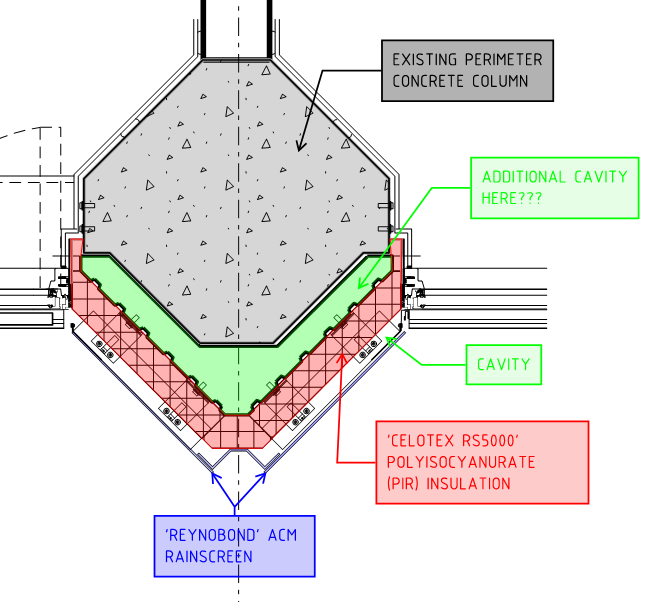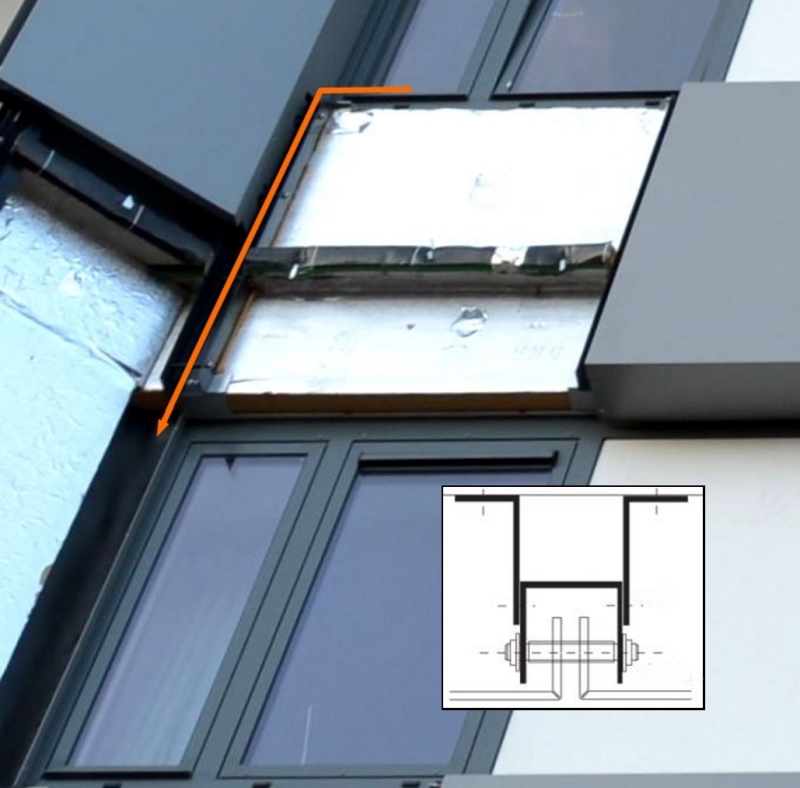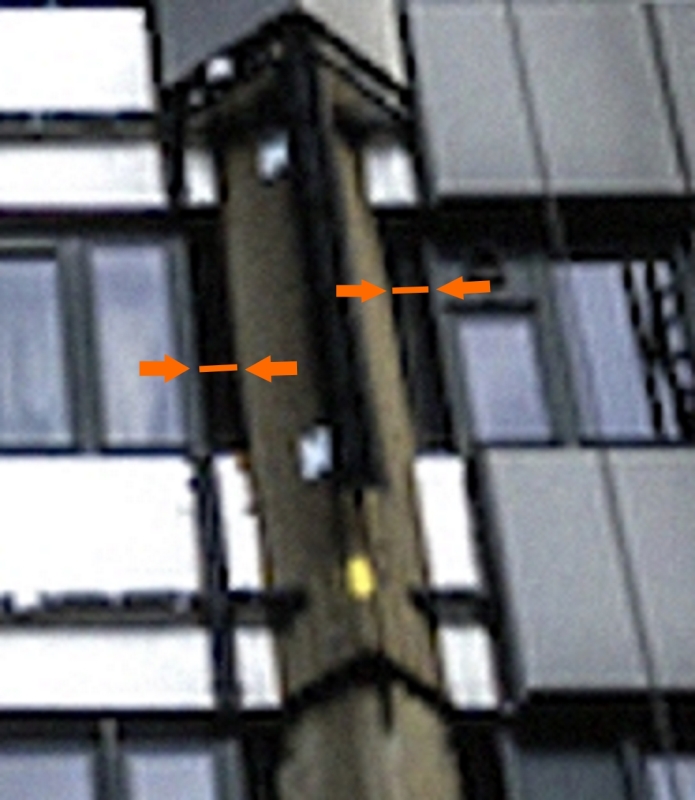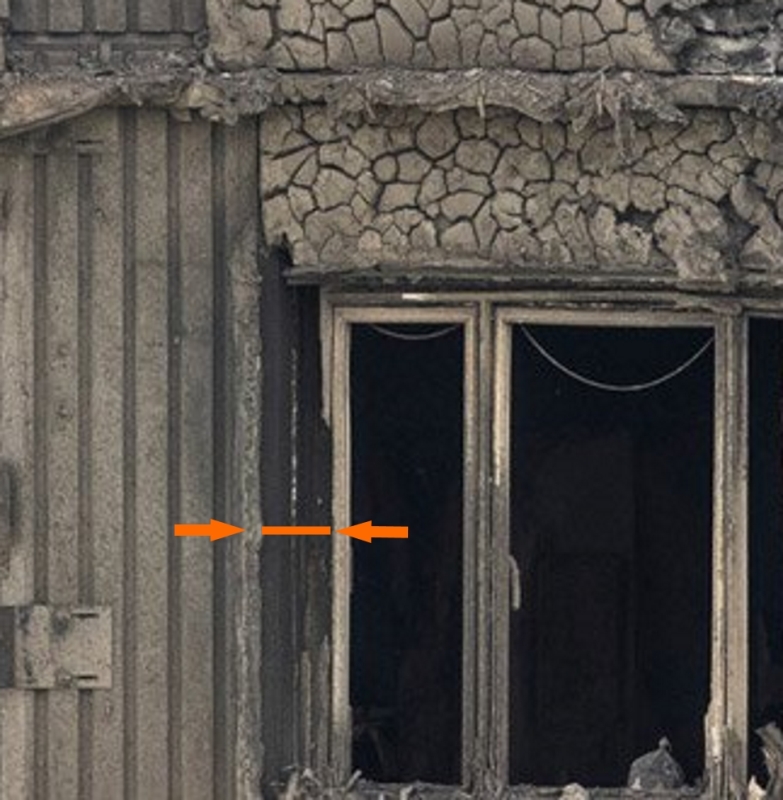Navigation
Install the app
How to install the app on iOS
Follow along with the video below to see how to install our site as a web app on your home screen.
Note: This feature may not be available in some browsers.
More options
Style variation
-
Congratulations cowski on being selected by the Eng-Tips community for having the most helpful posts in the forums last week. Way to Go!
You are using an out of date browser. It may not display this or other websites correctly.
You should upgrade or use an alternative browser.
You should upgrade or use an alternative browser.
24-level building tower fire in West London 33
- Thread starter Ingenuity
- Start date
- Status
- Not open for further replies.
- Thread starter
- #161
LitteInch said:I wonder if the deep corrugations on the column allowed flames / air to pass up the inside of the insulation
I think you may be correct. Looks like they used cold-formed steel to offset and attach the PIR to the existing column exterior, and creating an additional cavity: Plan-section of detail:

Ingenuity (Structural) - The green area in the section drawing with the note: Additional Cavity Here??? is representative of the concrete columns from the 3rd floor to ground. The green section from the 4th floor up represents the precast concrete fascia attached to the poured-in-place concrete columns. Either the precast concrete fascia was never added to the lower floors or it was removed sometime over the years. The original planning supplied by the architect for the refurbishment suggested a brick exterior on the lower floors but some other kind of fluted fascia was placed instead.
Does anyone know how they are testing the cladding on these other buildings? Sure, they can be flammable, but there are a lot of building materials out there that are flammable. They need to be designed properly so that the building is safe when everything is put together. The design of the wall assembly is important - not just what cladding material or insulation is used. I wonder what the British building code says regarding this type of cladding on a building at this height.
Fire tests being undertaken apparently do not fall under any British Standard or EU Standard. No one has filed a complaint through any of the professional organisations. It looks like the politicians are getting involved, from the Guardian,
"Building safety experts have warned that government tests on tower block cladding in the wake of the Grenfell Tower disaster lack transparency and are too simplistic to be used to condemn blocks as unsafe.
Fire risk consultants and architects have suggested the government should reveal what tests were being conducted on the material after it was revealed every single cladding sample sent for analysis had failed the new assessment.
The communities secretary, Sajid Javid, announced on Monday that samples of aluminium panels from all 75 buildings that had been sent for fire retardancy testing had so far 'failed'.
But he did not reveal what testing was undertaken apart from to say they determine whether the materials meet 'the requirement for limited combustibility in building regulations'.
The Department for Communities and Local Government (DCLG) asked councils to cut samples of at least 25cm x 25cm from the cladding of towers and send them to the Building Research Establishment (BRE) at Watford for testing but has not said if the tests show whether they meet a British standard test."
Dik
"Building safety experts have warned that government tests on tower block cladding in the wake of the Grenfell Tower disaster lack transparency and are too simplistic to be used to condemn blocks as unsafe.
Fire risk consultants and architects have suggested the government should reveal what tests were being conducted on the material after it was revealed every single cladding sample sent for analysis had failed the new assessment.
The communities secretary, Sajid Javid, announced on Monday that samples of aluminium panels from all 75 buildings that had been sent for fire retardancy testing had so far 'failed'.
But he did not reveal what testing was undertaken apart from to say they determine whether the materials meet 'the requirement for limited combustibility in building regulations'.
The Department for Communities and Local Government (DCLG) asked councils to cut samples of at least 25cm x 25cm from the cladding of towers and send them to the Building Research Establishment (BRE) at Watford for testing but has not said if the tests show whether they meet a British standard test."
Dik
BrianPetersen
Mechanical
Perhaps tests need to be done that should fall outside of any EU or British standard.
JohnRBaker
Mechanical
I hope this disaster has been on the minds of the people responsible for the oversight and enforcement of similar regulations here in the US, but I'm not holding my breath...
What The Grenfell Fire Could Teach Trump
The Trump administration has been loosening health and safety regulations since Day One.
John R. Baker, P.E. (ret)
EX-Product 'Evangelist'
Irvine, CA
Siemens PLM:
UG/NX Museum:
The secret of life is not finding someone to live with
It's finding someone you can't live without
What The Grenfell Fire Could Teach Trump
The Trump administration has been loosening health and safety regulations since Day One.
John R. Baker, P.E. (ret)
EX-Product 'Evangelist'
Irvine, CA
Siemens PLM:
UG/NX Museum:
The secret of life is not finding someone to live with
It's finding someone you can't live without
It takes time to learn not to do stupid things.
This seems to be the route of ingress of fire debris behind the cladding. The cold-formed steel hangers for the cladding form a boxed U-shaped channel. As flammable debris cascaded down between the gap between the 4th floor Column ACM cassette/panel & the Spandrel ACM cassette it would have channeled much of the debris to the inside of the 3rd floor Column ACM cassette. I'm speculating that the black material along side the insulation, is window flashing with a bituminous composition. Some of the flammable debris would have landed on the bottom of the forth floor Spandrel ACM cassette (3rd floor window soffit). So the "Hook & Pin" method of ACM suspended cladding installation created a vulnerability.


The window frames did not extend column to column. The vertical edge of the window frame stopped 6 inches or more from the columns. What was used to fill in this void is anyone's guess but it is this design attribute that compromised the compartmentalization of each of the flats. The use of, what I assume, is a ?rubberized/bituminous? window flashing, primed this void with a material much more flammable than the Reynobond Polyethylene ACM or the Celotex PIR Insulation board. The composition of such a material is a mixture of: Heavy Paraffinic Distillate Solvent Extract CAS# 064742-04-7 , Petroleum Asphalt CAS# 008052-42-4 & Styrene-Butadiene block copolymer CAS# 009003-55-8. The HMIS - Hazardous Material Identification System used on Material Safety Data Sheets, identifies such a composition as having a Fire Rating of 1. (Slight Hazard Materials that are normally stable, but can become unstable at high temperatures and pressures.) It has a flash point around 210C and, if left exposed, would be the most vulnerable material in the assembly.
The design decision to use the ACM Column cladding as the vertical edge of the window opening, doomed the safety of the interior of the flats.


The design decision to use the ACM Column cladding as the vertical edge of the window opening, doomed the safety of the interior of the flats.


From the Guardian, "Dozens of exposed gas pipes in Grenfell Tower that caused residents to fear for their safety were left bare despite a council safety expert ordering them to be protected by fire-retardant boxing.
The National Grid agreed to protect the pipes serving individual flats, which had been installed over the winter, but had only added a third of the boxing by the time the deadly blaze killed at least 79 people."
Link:
Dik
The National Grid agreed to protect the pipes serving individual flats, which had been installed over the winter, but had only added a third of the boxing by the time the deadly blaze killed at least 79 people."
Link:
Dik
dik (Structural) - I don't disagree. For the contractor, it comes down to the windows. They were able to use the same left hand & right hand windows on all 4 elevations by staying with just one size. It violated the Environmental Planning done with respect to natural lighting as set forth in the commissioned BREEAM study but it was less money, maybe.... The building required a total of 294 windows on the upper 21 floors. Instead of buying 84 Left-hand Windows & 84 Right-hand Windows, sized for the North & South elevations AND buying 63 Left-hand Windows & 63 Right-hand Windows sized wider for the East & West elevations. They bought 147 LH & 147 RH windows all of a smaller size. So it seems, they adjusted the volume of the column cavity to accommodate the uniform window sizing.
LittleInch
Petroleum
epoxybot - excellent drawings, pictures and commentary and it has been a thing I struggled with as well which was of course the outside cladding shouldn't catch fire and spread like it did, but even so how did it catch the whole building like it did and enter the flats as quickly as it did. Gaps around the window frames filled with something very combustible was my thought and this seems to give weight to that theory.
There was something very odd / different with those columns though which may or may not be replicated on long vertical sections on other buildings. Your picture in the post of 16 June 21:28 is still the most dramatic and alarming of the whole sequence leading to this appalling loss of life and injury.
You should volunteer this to the public Enquiry.
Remember - More details = better answers
Also: If you get a response it's polite to respond to it.
There was something very odd / different with those columns though which may or may not be replicated on long vertical sections on other buildings. Your picture in the post of 16 June 21:28 is still the most dramatic and alarming of the whole sequence leading to this appalling loss of life and injury.
You should volunteer this to the public Enquiry.
Remember - More details = better answers
Also: If you get a response it's polite to respond to it.
From the BBC, "Cladding from 120 high-rise buildings in 37 local authority areas in England has now failed fire safety tests, the prime minister has said.
Theresa May told the Commons it was a 100% failure rate, as all of the samples submitted so far since the Grenfell Tower fire had failed."
Link:
Dik
Theresa May told the Commons it was a 100% failure rate, as all of the samples submitted so far since the Grenfell Tower fire had failed."
Link:
Dik
There does not appear to be any comment on any of the news sites of Architectural malfeasance. No indication of who specified what, or if this had changed.
Added: I'm not sure what the role of an Architect is in the UK.
Also no reference to shop drawings that would have had reviewed construction details. The problems seem to be mounting: combustible material, appliance issues, electrical issues, and gas issues. Not sure what they did right.
Dik
Added: I'm not sure what the role of an Architect is in the UK.
Also no reference to shop drawings that would have had reviewed construction details. The problems seem to be mounting: combustible material, appliance issues, electrical issues, and gas issues. Not sure what they did right.
Dik
dik (Structural) - The project was tendered to be Design & Build by the bid winning contractor. The contractor would be responsible for all design work that was beyond the scope of the original planning documents developed by the architect. So the architect is responsible for choosing the rain-screen scenario and the decision to insulate the columns. The Design & Build contractor is responsible for the selection of the materials used to create the design. The architects original contracted role was architectural design consultant, prior to Novating.
Here is a UK link to Novating an Architect to a Design Build contract. Link
Design Build (scroll) Link
Liability Link
There may be considerable liability that falls on the property management company, KCTMO, in concert with the Contractor. The Decision Notice issued by the Town Planner specifically called out for the External Cladding & Windows to be submitted to the local planning authority Kensington & Chelsea. The reasons given by the Town Planner were largely esthetic but the Contractor seems to have done an end-run on the submittals process. The contractor staged a full scale mock-up in July/August of 2014 on a lower floor of Grenfell. They may have gotten a verbal acceptance but a actual submittal might have raised a red flag about the cheap material selection and the absence of an FR rating on the cladding.
LittleInch (Petroleum) - I think the Fire Inspection team already know that the gap between the window frame & the columns was the path of fire entry inside the flats. A number of photos from 2 days after the fire show fire inspectors (or possibly Structural Engineers) taking numerous photographs, principally focused on the column areas of the structure. This very large scale photo shows how intense the fire was at the columns. Link
Here is a UK link to Novating an Architect to a Design Build contract. Link
Design Build (scroll) Link
Liability Link
There may be considerable liability that falls on the property management company, KCTMO, in concert with the Contractor. The Decision Notice issued by the Town Planner specifically called out for the External Cladding & Windows to be submitted to the local planning authority Kensington & Chelsea. The reasons given by the Town Planner were largely esthetic but the Contractor seems to have done an end-run on the submittals process. The contractor staged a full scale mock-up in July/August of 2014 on a lower floor of Grenfell. They may have gotten a verbal acceptance but a actual submittal might have raised a red flag about the cheap material selection and the absence of an FR rating on the cladding.
LittleInch (Petroleum) - I think the Fire Inspection team already know that the gap between the window frame & the columns was the path of fire entry inside the flats. A number of photos from 2 days after the fire show fire inspectors (or possibly Structural Engineers) taking numerous photographs, principally focused on the column areas of the structure. This very large scale photo shows how intense the fire was at the columns. Link
Epoxybot:
I read somewhere that an Architect had to be used by the design builder and that it was recommended the original architect should be used, but not mandatory. In any event, a chartered Architect was a requirement. Architects are normally responsible for the design of the building envelope.
Added: Materials selected, in any event, would have to comply with whatever codes are in effect. It may be that UK building codes permitted the construction of fire traps.
From the liability Link you provided, which was excellent:
Dik
I read somewhere that an Architect had to be used by the design builder and that it was recommended the original architect should be used, but not mandatory. In any event, a chartered Architect was a requirement. Architects are normally responsible for the design of the building envelope.
Added: Materials selected, in any event, would have to comply with whatever codes are in effect. It may be that UK building codes permitted the construction of fire traps.
From the liability Link you provided, which was excellent:
https://www.designingbuildings.co.uk/wiki/Liability_for_building_design#Design_and_Build_Contractors
does not really clarify things and indicates that certain degrees of competency are required. It appears the British system does not hold Architects, and perhaps Engineers, to account like the model established in North America. I guess we'll have to wait and see what 'shakes out'. I'm really surprised there has been no mention in the news of this and that there is not a line up of lawyers.Dik
I really don't buy the argument that the Hotpoint Refrigerator is the defacto cause of the fire. Yes it caught fire and the blaze in the flat set fire to the external cladding but a refrigerator that sold over 67,000 units and was discontinued in 2009 and has had a limited number of catastrophic events does not appear to me a defect of manufacturer design or manufacture. That said, by British Standards specification, the power cord for most UK refrigerators are undersized for the current the draws when the motor starts. This is allowed because the cord is under 2 meters in length. It is just one more example of how politics have invaded safety. After all, who would ever plug a refrigerator into an extension cord? Of course manufacturer documentation in the UK & here in the US say, you should never plug a large appliance into an extension cord, yet appliance extension cords are sold by the same people who sell the refrigerators. Consider with the catastrophic failure of the Grenfell Towers electrical system in May 2013 after 3 weeks of power surges & brown outs, what effect that would have had on a power cord that was intentionally undersized by British Standards. Any investigation that stops short of opening the walls of the undamaged flats to access wear & tear of the building's wiring and likewise examining the state of the remaining appliances, will not be a though examination of the cause of the fire.
It is too bad we do not know where the refrigerator was located, though photos of other fire ravaged units suggest it may have been close to the window. Knowing now that the window frames do not extend to column, it raises the question if the fire damaged the wall at the column/window frame interface, inside the flat. What the tenant of the 4th floor flat can tell regarding the actions of the Fire Brigade, the resulting damage, if the window was open, or the kitchen exhaust fan turned on and the location of the refrigerator will be interesting.
Am I the only one curious about the panic inducing statements coming from government?
It is too bad we do not know where the refrigerator was located, though photos of other fire ravaged units suggest it may have been close to the window. Knowing now that the window frames do not extend to column, it raises the question if the fire damaged the wall at the column/window frame interface, inside the flat. What the tenant of the 4th floor flat can tell regarding the actions of the Fire Brigade, the resulting damage, if the window was open, or the kitchen exhaust fan turned on and the location of the refrigerator will be interesting.
Am I the only one curious about the panic inducing statements coming from government?
- Status
- Not open for further replies.
Similar threads
- Replies
- 28
- Views
- 2K
- Replies
- 25
- Views
- 25K
- Question
- Replies
- 8
- Views
- 12K
- Locked
- Question
- Replies
- 20
- Views
- 1K
- Replies
- 21
- Views
- 9K
